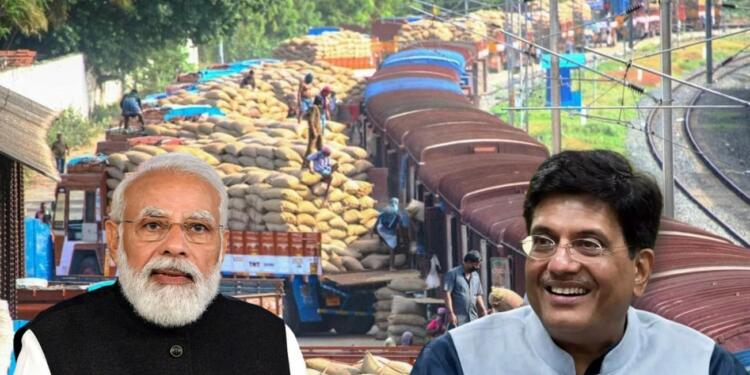India is scoring big on all major economic parameters. Circumventing two deadly covid waves that brought the entire globe to its knees, the Modi government has made sure that India continues to rise on the export front and clock a stellar growth trajectory. The merchandise exports and agricultural exports are at an all-time historic high. While the naysayers believe that India’s economy is in a bad shape the data has been proving them wrong consistently. Mind you, India is clocking economic successes at a time when China’s export-dependent economy has begun unwinding.
According to recently released official data, India’s merchandise exports touched a high of $418 billion in the 2021-22 fiscal — exceeding the government’s target by about 5 per cent and recording a 40 per cent growth over the previous year. In the FY 2020-21 merchandise exports stood at only $292 billion.
Union Commerce and Industry minister Piyush Goyal in a media interaction about the feat remarked, “India has exported $418 billion for the first time in its history. This is more than the target. It has crossed $40 billion in exports in March alone, the maximum in a single month. India’s diversified export portfolio in 2021-22 shows India’s manufacturing abilities, and growth in hi-tech goods, electronics, and agricultural products.,”
PLI scheme and its overwhelming success in merchandise exports
As reported extensively by TFI, India’s success in merchandise exports comes in the backdrop of the global pandemic which had disrupted the supply chain. China – the world’s factory dropped the towel and countries across the globe were left scrambling around in search of alternatives.
Sensing a window of opportunity, the Modi government swooped in and in March 2020, launched the PLI scheme, and fast forward to today. The same has been extended to nearly 10 vital sectors of the economy and the results are already overwhelming.
Also read: India’s exports hit record high riding on the success of the PLI schemes
India to export 100 lakh tonnes of wheat
While the merchandise exports are touching a new high every month, it is double engine growth for the Indian economy as agricultural exports are also recording historic numbers.
According to a Financial Express report, the country’s wheat exports are likely to cross 100 lakh tonnes (10 million tonnes) during FY 2022-23. The exports have already crossed 70 lakh tonnes in 2021-22 (worth over Rs 15,000 crore) as against 21.55 lakh tonnes (over Rs 4,000 crore) in 2020-21.
The numbers become even more significant when it is realised that up until two years ago (2019-20) the exports stood at only two lakh tonnes (Rs 500 crore).
Speaking about breaching the 100-lakh tonne barrier, Piyush Goyal added, “We will continue to export wheat in a big way and meet the needs of the countries that are not getting their supplies from the conflict areas, and my own sense is that this time we will probably exceed our wheat exports (of) over 100 lakh tonnes comfortably,”
The world is facing a wheat shortage
It is pertinent to note that agricultural commodities have huge demand in global markets as many major agricultural producers are either facing climatic problems or some geopolitical issue. Amid the ongoing disturbances, India has emerged as the trusted supplier of food to countries around the world.
Ever since Russia invaded Ukraine, wheat futures shot up to a record of more than $14 a bushel, and are now trading at close to $9.8 per bushel (1 Bushel ≈ 30 kgs).
Together, Russia and Ukraine make up about 30 per cent of global wheat exports. Russia has been sanctioned, and Ukraine has banned wheat exports. That leaves the world, especially Europe in a very precarious situation.
Indian farmers have started harvesting wheat unlike their western compatriots
India has a distinct advantage over other countries when it comes to filling the void that the absence of Ukrainian and Russian wheat supplies has caused around the world. The rabi crop has started to arrive at the mandis in the last couple of weeks and will be completely harvested by the end of April or mid-May.
Meanwhile, global producers are still waiting for the June-July period to harvest their crops which will only reach the markets by August-September. With this, India has the opportunity to pounce and flood the global markets with its superior wheat.
Read More: A hungry Europe looks coyly at India’s wheat, and India will feed it
Already, India is in final talks to start wheat exports to Egypt – one of the largest importers of wheat from Ukraine as well as Russia. Separately, the Modi government is also in discussions with countries such as Turkey, China, Bosnia, Sudan, Nigeria, and Iran among others, to start wheat exports.
Private procurers are offering farmers up to Rs 2,700 a quintal. Therefore, farmers are poised to make an additional profit of close to Rs 600, considering the fact that the government procures one quintal of wheat at Rs 2,015.
Read More: Agriculture is all set to write the golden chapter of the Indian Economy
Moreover, India is the world’s largest producer as well as exporter of rice. In 2019, India exported rice worth 7.1 billion dollars, accounting for 32 per cent of the global rice export. In 2020, major rice exporters like Vietnam and China were also forced to import the grain from India.
India covering its bases and proving itself as the true superpower
India is poised to clock impressive export numbers in the coming years. By forging beneficial FTAs with countries like the UAE and Australia, India is covering its bases and ensuring that these exports numbers are not a one-off instance.
There was a time when India had to feed its population using the crumbs thrown at it by rich and powerful countries in the West. The food which was dumped in India was of low quality. Today, that same India will export high-quality grains to the supposed “superpowers” of the world, so that their populations do not get wiped out due to hunger.































